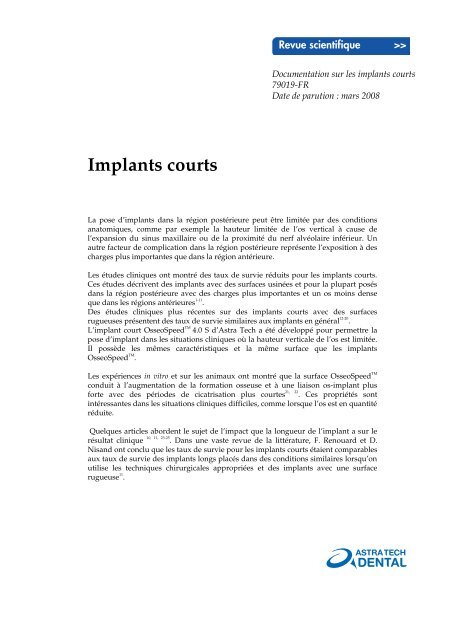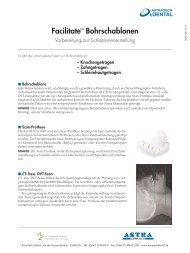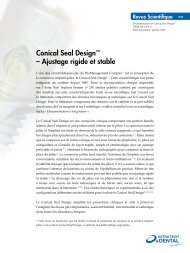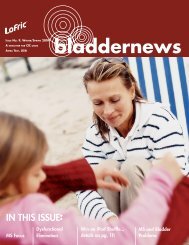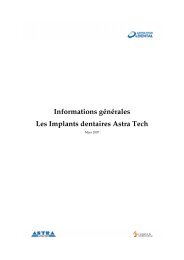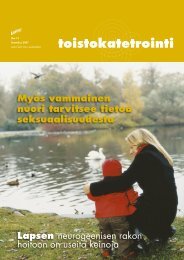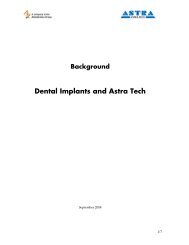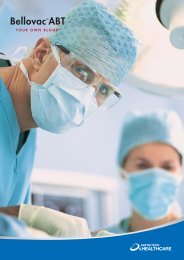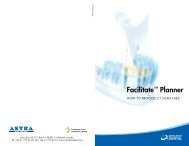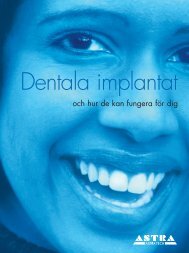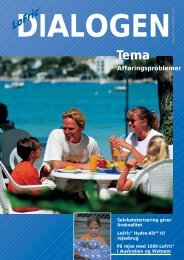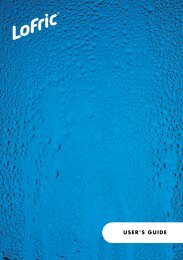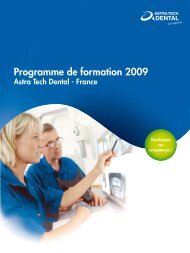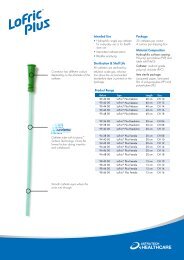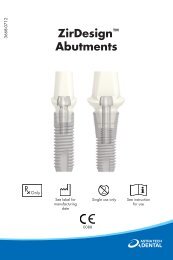Implants courts - Astra Tech
Implants courts - Astra Tech
Implants courts - Astra Tech
Create successful ePaper yourself
Turn your PDF publications into a flip-book with our unique Google optimized e-Paper software.
Revue scientifique >><br />
Documentation sur les implants <strong>courts</strong><br />
79019-FR<br />
Date de parution : mars 2008<br />
<strong>Implants</strong> <strong>courts</strong><br />
La pose d’implants dans la région postérieure peut être limitée par des conditions<br />
anatomiques, comme par exemple la hauteur limitée de l’os vertical à cause de<br />
l’expansion du sinus maxillaire ou de la proximité du nerf alvéolaire inférieur. Un<br />
autre facteur de complication dans la région postérieure représente l’exposition à des<br />
charges plus importantes que dans la région antérieure.<br />
Les études cliniques ont montré des taux de survie réduits pour les implants <strong>courts</strong>.<br />
Ces études décrivent des implants avec des surfaces usinées et pour la plupart posés<br />
dans la région postérieure avec des charges plus importantes et un os moins dense<br />
que dans les régions antérieures 1-11 .<br />
Des études cliniques plus récentes sur des implants <strong>courts</strong> avec des surfaces<br />
rugueuses présentent des taux de survie similaires aux implants en général 12-20 .<br />
L’implant court OsseoSpeed TM 4.0 S d’<strong>Astra</strong> <strong>Tech</strong> a été développé pour permettre la<br />
pose d’implant dans les situations cliniques où la hauteur verticale de l’os est limitée.<br />
Il possède les mêmes caractéristiques et la même surface que les implants<br />
OsseoSpeed TM .<br />
Les expériences in vitro et sur les animaux ont montré que la surface OsseoSpeed TM<br />
conduit à l’augmentation de la formation osseuse et à une liaison os-implant plus<br />
forte avec des périodes de cicatrisation plus courtes 21, 22 . Ces propriétés sont<br />
intéressantes dans les situations cliniques difficiles, comme lorsque l’os est en quantité<br />
réduite.<br />
Quelques articles abordent le sujet de l’impact que la longueur de l’implant a sur le<br />
résultat clinique 10, 11, 23-25 . Dans une vaste revue de la littérature, F. Renouard et D.<br />
Nisand ont conclu que les taux de survie pour les implants <strong>courts</strong> étaient comparables<br />
aux taux de survie des implants longs placés dans des conditions similaires lorsqu’on<br />
utilise les techniques chirurgicales appropriées et des implants avec une surface<br />
rugueuse 11 .
Références<br />
Les tirés à part peuvent être commandés avec le numéro de référence<br />
1. Friberg B, Jemt T, Lekholm U. Early failures in<br />
4,641 consecutively placed Branemark dental<br />
implants: a study from stage 1 surgery to the<br />
connection of completed prostheses. Int J Oral<br />
Maxillofac <strong>Implants</strong> 1991;6(2):142-6.<br />
2. Bahat O. Treatment planning and placement of<br />
implants in the posterior maxillae: report of 732<br />
consecutive Nobelpharma implants. Int J Oral<br />
Maxillofac <strong>Implants</strong> 1993;8(2):151-61.<br />
3. Bahat O. Branemark system implants in the<br />
posterior maxilla: clinical study of 660 implants<br />
followed for 5 to 12 years. Int J Oral Maxillofac<br />
<strong>Implants</strong> 2000;15(5):646-53.<br />
4. Jemt T, Lekholm U. Implant treatment in<br />
edentulous maxillae: a 5-year follow-up report<br />
on patients with different degrees of jaw<br />
resorption. Int J Oral Maxillofac <strong>Implants</strong><br />
1995;10(3):303-11.<br />
5. Naert I, Koutsikakis G, Duyck J, Quirynen M,<br />
Jacobs R, van Steenberghe D. Biologic outcome of<br />
implant-supported restorations in the treatment<br />
of partial edentulism. part I: a longitudinal<br />
clinical evaluation. Clin Oral <strong>Implants</strong> Res<br />
2002;13(4):381-9.<br />
6. Weng D, Jacobson Z, Tarnow D, Hurzeler MB,<br />
Faehn O, Sanavi F, et al. A prospective<br />
multicenter clinical trial of 3i machined-surface<br />
implants: results after 6 years of follow-up. Int J<br />
Oral Maxillofac <strong>Implants</strong> 2003;18(3):417-23.<br />
7. Jaffin RA, Berman CL. The excessive loss of<br />
Branemark fixtures in type IV bone: a 5-year<br />
analysis. J Periodontol 1991;62(1):2-4.<br />
8. Tawil G, Younan R. Clinical evaluation of<br />
short, machined-surface implants followed for 12<br />
to 92 months. Int J Oral Maxillofac <strong>Implants</strong><br />
2003;18(6):894-901.<br />
9. Friberg B, Grondahl K, Lekholm U, Branemark<br />
PI. Long-term follow-up of severely atrophic<br />
edentulous mandibles reconstructed with short<br />
Branemark implants. Clin Implant Dent Relat<br />
Res 2000;2(4):184-9.<br />
10. das Neves FD, Fones D, Bernardes SR, do<br />
Prado CJ, Neto AJ. Short implants--an analysis of<br />
longitudinal studies. Int J Oral Maxillofac<br />
<strong>Implants</strong> 2006;21(1):86-93.<br />
11. Renouard F, Nisand D. Impact of implant<br />
length and diameter on survival rates. Clin Oral<br />
<strong>Implants</strong> Res 2006;17 Suppl 2:35-51.<br />
12. Fugazzotto PA, Beagle JR, Ganeles J, Jaffin R,<br />
Vlassis J, Kumar A. Success and failure rates of 9<br />
mm or shorter implants in the replacement of<br />
missing maxillary molars when restored with<br />
individual crowns: preliminary results 0 to 84<br />
months in function. A retrospective study. J<br />
Periodontol 2004;75(2):327-32.<br />
13. Renouard F, Nisand D. Short implants in the<br />
severely resorbed maxilla: a 2-year retrospective<br />
clinical study. Clin Implant Dent Relat Res 2005;7<br />
Suppl 1:S104-10.<br />
14. Cecchinato D, Olsson C, Lindhe J. Submerged<br />
or non-submerged healing of endosseous<br />
implants to be used in the rehabilitation of<br />
partially dentate patients. J Clin Periodontol<br />
2004;31(4):299-308. (Ref. No. 78302)<br />
15. Buser D, Mericske-Stern R, Bernard JP,<br />
Behneke A, Behneke N, Hirt HP, et al. Long-term<br />
evaluation of non-submerged ITI implants. Part<br />
1: 8-year life table analysis of a prospective<br />
multicenter study with 2359 implants. Clin Oral<br />
<strong>Implants</strong> Res 1997;8(3):161-72.<br />
16. Brocard D, Barthet P, Baysse E, Duffort JF,<br />
Eller P, Justumus P, et al. A multicenter report on<br />
1,022 consecutively placed ITI implants: a 7-year<br />
longitudinal study. Int J Oral Maxillofac <strong>Implants</strong><br />
2000;15(5):691-700.<br />
17. Nedir R, Bischof M, Briaux JM, Beyer S,<br />
Szmukler-Moncler S, Bernard JP. A 7-year life<br />
table analysis from a prospective study on ITI<br />
implants with special emphasis on the use of<br />
short implants. Results from a private practice.<br />
Clin Oral <strong>Implants</strong> Res 2004;15(2):150-7.<br />
18. Mericske-Stern R, Grutter L, Rosch R,<br />
Mericske E. Clinical evaluation and prosthetic<br />
complications of single tooth replacements by<br />
non-submerged implants. Clin Oral <strong>Implants</strong> Res<br />
2001;12(4):309-18.<br />
19. Levine RA, Clem D, Beagle J, Ganeles J,<br />
Johnson P, Solnit G, et al. Multicenter<br />
retrospective analysis of the solid-screw ITI<br />
implant for posterior single-tooth replacements.<br />
Int J Oral Maxillofac <strong>Implants</strong> 2002;17(4):550-6.<br />
20. Romeo E, Ghisolfi M, Rozza R, Chiapasco M,<br />
Lops D. Short (8-mm) dental implants in the<br />
rehabilitation of partial and complete<br />
edentulism: a 3- to 14-year longitudinal study.<br />
Int J Prosthodont 2006;19(6):586-92.<br />
21. Berglundh T, Abrahamsson I, Albouy JP,<br />
Lindhe J. Bone healing at implants with a<br />
fluoride-modified surface: an experimental study<br />
in dogs. Clin Oral Impl Res 2007;18(2):147-52.<br />
(Ref. No. 78775)<br />
22. Ellingsen JE, Johansson CB, Wennerberg A,<br />
Holmén A. Improved retention and<br />
bonetolmplant contact with fluoride-modified<br />
titanium implants. Int J Oral Maxillofac <strong>Implants</strong><br />
2004;19(5):659-66. (Ref. No. 78245)<br />
23. Misch CE. Short dental implants: a literature<br />
review and rationale for use. Dent Today<br />
2005;24(8):64-6, 68.<br />
24. Hagi D, Deporter DA, Pilliar RM, Arenovich<br />
T. A targeted review of study outcomes with<br />
short (< or = 7 mm) endosseous dental implants<br />
placed in partially edentulous patients. J<br />
Periodontol 2004;75(6):798-804.<br />
25. Morand M, Irinakis T. The challenge of<br />
implant therapy in the posterior maxilla:<br />
providing a rationale for the use of short<br />
implants. J Oral Implantol 2007;33(5):257-66.<br />
*0,112€ TTC les 1ères 56 secondes, 0,09€ TTC la minute suivante<br />
<strong>Astra</strong> <strong>Tech</strong> France- 7, rue Eugène & Armand Peugeot- 92563 Rueil-Malmaison Cedex<br />
N° Service Clients : 0821 20 01 01*- Fax Service Clients : 01 41 39 97 42- E-mail : commandeIP.france@astratech.com - Site : www.astratechdental.fr


